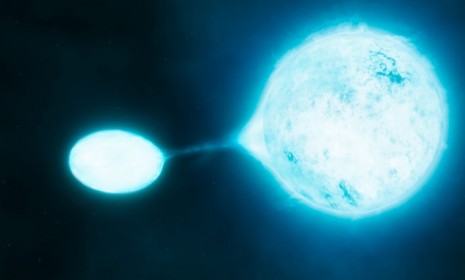The surprising prevalence of killer 'vampire stars'
Some of our galaxy's biggest, brightest stars are members of binary systems — and they're sucking the life right out of their partner stars

Scientists have long known that some of the biggest, brightest stars in our galaxy are part of binary two-star systems. But a new study suggests that far more of these stellar duos exist than once believed, with many exhibiting signs of a violent relationship. Indeed, in many pairs, one "vampire star" will often suck the life from its partner to become bigger, more powerful, and more luminous. Here's what you should know:
What sort of stars are we talking about?
They're called Type O stars, and "are absolute behemoths," says study co-author Hugues Sana at the University of Amsterdam. "They have 15 or more times the mass of our sun and can be up to a million times brighter." Type O stars have surface temperatures that reach a scorching 54,000 degrees Fahrenheit, and typically lead "short, violent lives," says Space.com's Denise Chow. These massive giants often die in illustrious explosions like "core-collapse supernovas or gamma-ray bursts," which are so bright they can be seen throughout most of the universe.
The Week
Escape your echo chamber. Get the facts behind the news, plus analysis from multiple perspectives.

Sign up for The Week's Free Newsletters
From our morning news briefing to a weekly Good News Newsletter, get the best of The Week delivered directly to your inbox.
From our morning news briefing to a weekly Good News Newsletter, get the best of The Week delivered directly to your inbox.
Okay. And what did scientists find in this case?
Scientists used the European Southern Observatory's Very Large Telescope in Chile to analyze dozens of Type O stars, both of the single and binary variety, roughly 6,000 light years away. To their surprise, about 75 percent of all Type O stars formed one half of a binary system — a much higher percentage than previously thought. More startlingly, most of these duos were close enough to interact with one another, sometimes combining into a single star, or forming a turbulent partnership in which one vampire star parasitically drained mass from the other.
What happens when these vampire stars start feeding?
Usually a vampire star starts off as the smaller member of a binary system, before slowly sucking the hydrogen from its companion. Over time, the vampire star grows larger, lives longer, and leaves its companion a withered star with an exposed core, says Brid-Aine Parnell at The Register. Sometimes, the vampire star steals so much material from its companion that the pair become a single star.
A free daily email with the biggest news stories of the day – and the best features from TheWeek.com
What does this mean for our understanding of stars?
Because the stripped-down victim star "is left with an exposed core that mimics the appearance of a much younger star," says Chow, vampire star binaries may be giving "researchers misleading information about galaxies and the stars within them." This new revelation may require scientists to reassess what they think they know about many stars in our universe.
Sources: TG Daily, The Register, Space.com
-
 US citizens are carrying passports amid ICE fears
US citizens are carrying passports amid ICE fearsThe Explainer ‘You do what you have to do to avoid problems,’ one person told The Guardian
-
 All roads to Ukraine-Russia peace run through Donetsk
All roads to Ukraine-Russia peace run through DonetskIN THE SPOTLIGHT Volodymyr Zelenskyy is floating a major concession on one of the thorniest issues in the complex negotiations between Ukraine and Russia
-
 Why is Trump killing off clean energy?
Why is Trump killing off clean energy?Today's Big Question The president halts offshore wind farm construction